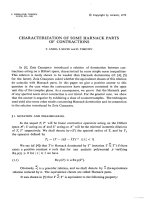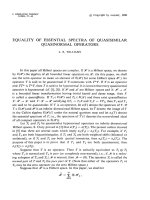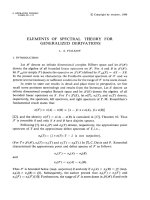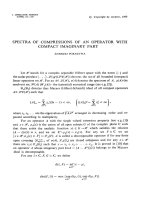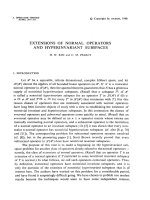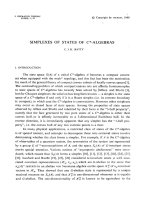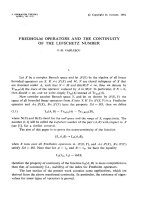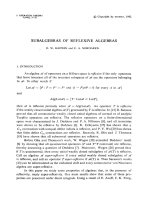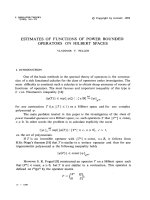Báo cáo toán học: "Products of Factorial Schur Functions" pptx
Bạn đang xem bản rút gọn của tài liệu. Xem và tải ngay bản đầy đủ của tài liệu tại đây (155.21 KB, 12 trang )
Products of Factorial Schur Functions
Victor Kreiman
Department of Mathematics
University of Georgia
Athens, GA 30602 USA
Submitted: Mar 9, 2008; Accepted: Jun 10, 2008; Published: Jun 20, 2008
Mathematics Subject Classifications: 05E05, 05E10
Abstract
The product of any finite number of factorial Schur functions can be expanded
as a Z[y]-linear combination of Schur functions. We give a rule for computing the
coefficients in such an expansion. This rule generalizes the classical Littlewood-
Richardson rule and several special cases of the Molev-Sagan rule.
1 Introduction
Let P
n
denote the set of partitions {λ = (λ
1
, . . . , λ
n
) ∈ N
n
| λ
1
≥ · · · ≥ λ
n
}, and for
λ ∈ P
n
, let T
λ
denote the set of all semistandard Young tableaux of shape λ with entries
in {1, . . . , n}. Let x = (x
1
, . . . , x
n
) and y = (y
1
, y
2
, . . .) be two sets of variables. The
Schur function s
λ
(x) and factorial Schur function s
λ
(x | y) are defined as follows:
s
λ
(x) =
T ∈T
λ
a∈T
x
a
and s
λ
(x | y) =
T ∈T
λ
a∈T
x
a
+ y
a+c(a)−r(a)
,
where for entry a ∈ T, c(a) and r(a) are the column and row numbers of a respectively.
Note that if y is specialized to (0, 0, . . .), then s
λ
(x | y) = s
λ
(x). Factorial Schur functions
are special cases of double Schubert polynomials [LS1, LS2] (see [La1] for discussion).
The factorial Schur function s
λ
(x | y), with y specialized to (0, −1, −2, −3, . . .), was first
defined by Biedenbarn and Louck [BL1, BL2], and further studied by Chen and Louck
[CL]. The factorial Schur function s
λ
(x | y), as defined above, is due to Macdonald [Ma2]
and Goulden and Greene [GG]. Factorial Schur functions appear in the study of the
center of the enveloping algebra U(gl
n
) (see Okounkov [Ok], Okounkov and Olshanski
[OO], Nazarov [Na], Molev [Mo2, Mo1], and Molev and Sagan [MS]), and the equivariant
cohomology of the Grassmannian (see Knutson and Tao [KT], Molev [Mo1], and Kreiman
[Kr]).
the electronic journal of combinatorics 15 (2008), #R84 1
Let r ∈ N. For i ∈ {1, . . . , r}, let y
(i)
= (y
(i)
1
, y
(i)
2
, . . .) be an infinite set of variables,
and let y denote the set of variables (y
(1)
, . . . , y
(r)
). As λ varies over P
n
, both the Schur
functions s
λ
(x) and the factorial Schur functions s
λ
(x | y
(i)
) (where i ∈ {1, . . . , r} is fixed)
form Z[y]-bases for Z[x, y]
S
n
, the ring of polynomials in the x and y variables which are
symmetric in the x variables. Hence for any sequence λ = (λ
(1)
, . . . , λ
(r)
) of elements of
P
n
, the polynomial s
λ
(x | y) = s
λ
(1)
(x | y
(1)
) · · · s
λ
(r)
(x | y
(r)
) can be expanded as a Z[y]-
linear combination of Schur functions:
s
λ
(x | y) =
µ∈P
n
c
µ
λ
(y)s
µ
(x), for some c
µ
λ
(y) ∈ Z[y]. (1)
We give a rule for computing the coefficients c
µ
λ
(y) for arbitrary λ.
When y
(1)
= · · · = y
(r)
= (0, 0, . . .), the coefficients c
µ
λ
(y) are classical Littlewood-
Richardson coefficients. Various rules for these coefficients are well known (see, for ex-
ample, [Ma1, (4.38’)], [RS, Corollary 6]). The following special cases of our rule coincide
with special cases of Molev-Sagan [MS, Theorem 3.1]: r = 2 and y
(1)
= (0, 0, . . .); r = 2
and y
(1)
= y
(2)
= (0, 0, . . .); and r = 1. The third of these special cases, namely r = 1,
gives the change of Z[y]-basis coefficients between the Schur and factorial Schur functions.
Another tableau-based rule for these change of basis coefficients is given by Molev [Mo1],
and a determinantal formula is given by Macdonald [Ma2]. More generally, change of
basis coefficients between Schubert and double Schubert polynomials were obtained by
Lascoux (see [La3, Theorem 10.2.6] and Macdonald [Ma1, (6.3) and (6.7)]).
A related problem is to expand s
λ
(x | y) in the basis of factorial Schur functions
{s
µ
(x | y
(1)
), µ ∈ P
n
}. A solution to this problem for r = 2 was given by Molev-Sagan
[MS, Theorem 3.1]. A solution for r = 2 and y
(1)
= y
(2)
which is positive in the sense of
Graham [Gr] was given by Knutson and Tao [KT]. Knutson and Tao’s rule is expressed
in terms of puzzles. Molev [Mo1] and Kreiman [Kr] give a tableau-based rule which is
equivalent to the Knutson-Tao puzzle rule.
The proof of our rule for c
µ
λ
(y) generalizes a concise proof by Stembridge [St] of the
classical Littlewood-Richardson rule. Stembridge’s proof relies on sign-reversing involu-
tions on skew tableaux which were introduced by Bender and Knuth [BK]. We generalize
these arguments and constructions to barred skew tableaux, which are refinements of
skew tableaux. Our proof is similar to but simpler than the proof used in [Kr], where
Stembridge’s methods are generalized to hatted skew tableaux.
Acknowledgements. We thank W. Graham and A. Molev for helpful comments and
discussions. We also thank the referee for useful suggestions and remarks.
2 Computing the Coefficients c
µ
λ
(y)
An element λ = (λ
1
, . . . , λ
n
) ∈ P
n
can also be regarded as the Young diagram whose i-th
row has λ
i
boxes. As above, let λ = (λ
(1)
, . . . , λ
(r)
) be a sequence of elements in P
n
, which
we regard as a sequence of Young diagrams. Denote also by λ the skew diagram formed
by placing each Young diagram in the sequence λ
(1)
, . . . , λ
(r)
below and to the left of the
the electronic journal of combinatorics 15 (2008), #R84 2
preceding one. A barred skew tableau T of shape λ is a filling of the boxes of the
skew diagram λ with elements of {1, . . . , n} ∪ {1, . . . , n} in such a way that the entries
weakly increase along any row from left to right and strictly increase along any column
from top to bottom, without regard to whether or not the entries are barred.
The unbarred column word of T is the sequence of unbarred entries of T obtained
by beginning at the top of the rightmost column, reading down, then moving to the top of
the next to rightmost column and reading down, etc. (the barred entries are just skipped
over in this process). We say that the unbarred column word of T is Yamanouchi if,
when one writes down its entries and stops at any point, one will have written at least
as many ones as twos, at least as many twos as threes, etc. The unbarred content
of T is ω(T ) = (ξ
1
, . . . , ξ
n
) ∈ N
n
, where ξ
k
is the number of unbarred k’s in T. Define
c
T
(y) =
y
(i(a))
a+c(a)−r(a)
, where the product is over all barred a ∈ T , i(a) is the index of the
particular Young diagram in which a resides, and c(a) and r(a) denote the column and
row numbers of a in this Young diagram.
5
4
5
3
3
4
5
1
1 1 1 2
4
3 4
3 3
2 2
1 1
1
1
Figure 1: A barred skew tableau T of shape λ and unbarred content µ, where λ =
((4, 2, 2), (2, 1), (5, 4, 2, 1)), and µ = ω(T ) = (6, 3, 3, 3, 1). The unbarred column word
of T is 1123123421141345, which is Yamanouchi. Thus T ∈ LR
µ
λ
. We have c
T
(y) =
a∈T,a barred
y
(i(a))
a+c(a)−r(a)
= y
(1)
1+3−1
y
(2)
3+1−1
y
(2)
4+2−1
y
(3)
1+1−1
y
(3)
3+2−2
y
(3)
5+4−2
y
(3)
5+2−3
= y
(1)
3
y
(2)
3
y
(2)
5
y
(3)
1
y
(3)
3
y
(3)
7
y
(3)
4
.
Definition 2.1. Denote the set of all barred skew tableaux of shape λ by B
λ
, and the set
of all barred skew tableaux of B
λ
of unbarred content µ whose unbarred column words are
Yamanouchi by LR
µ
λ
.
Theorem 2.2. c
µ
λ
(y) =
T ∈LR
µ
λ
c
T
(y) =
T ∈LR
µ
λ
a∈T
a barred
y
(i(a))
a+c(a)−r(a)
.
Example 2.3. Let n = 2, λ = ((2, 1), (1, 1)), and µ = (2, 2). We list all T ∈ LR
µ
λ
, and
for each T we give c
T
(y):
the electronic journal of combinatorics 15 (2008), #R84 3
2
1
2
1
1
c
T
(y) = y
(1)
1
2
1
2
1
1
c
T
(y) = y
(1)
2
2
1
2
1
2
c
T
(y) = y
(1)
3
2
1
2
1 1
c
T
(y) = y
(2)
1
By Theorem 2.2, c
µ
λ
(y) = y
(1)
1
+ y
(1)
2
+ y
(1)
3
+ y
(2)
1
.
Remark 2.4. If y
(i)
is specialized to (0, 0, . . .) for some i, then s
λ
(i)
(x | y
(i)
) = s
λ
(i)
(x). In
this case, if T ∈ LR
µ
λ
has a barred entry in Young diagram λ
(i)
, then c
T
(y) = 0. Thus
in Theorem 2.2, c
µ
λ
(y) is computed by summing over only those T ∈ LR
µ
λ
with no barred
entries in Young diagram λ
(i)
.
Remark 2.5. For simplicity, we assume here that y := y
(1)
= · · · = y
(r)
, and we denote
y by just y. Theorem 2.2 has the following representation-theoretic interpretation. Let
G = GL
n
(C), and let H = C
∗
× C
∗
× · · · . For λ ∈ P
n
, let V
λ
denote the irreducible
G-representation of highest weight λ. For m ∈ Z[y] = Z[y
1
, y
2
, . . .] a monomial with
coefficient 1, let L
m
denote the H representation with character m. For λ ∈ P
n
, define
the following G × H representation:
U
λ
=
µ∈P
n
T ∈LR
µ
(λ)
V
µ
⊗ L
c
T
(y)
.
By Theorem 2.2, Char
G×H
U
λ
=
µ∈P
n
, T ∈L
µ
(λ)
s
µ
(x)c
T
(y) = s
µ
(x | y).
Let R(G × H) denote the polynomial representation ring of G × H (i.e., the subring
of the full representation ring of G × H generated by the polynomial representations)
and R(H) the polynomial representation ring of H. Then R(G × H)
∼
=
Z[x]
S
n
⊗ Z[y] =
Z[x, y]
S
n
, and R(H)
∼
=
Z[y]. Since {s
λ
(x | y) | λ ∈ P
n
} forms a Z[y]-basis for Z[x, y]
S
n
,
the classes {[U
λ
] | λ ∈ P
n
} ⊂ R(G × H) form an R(H)-basis for R(G × H). Theorem 2.2
implies the following decomposition as G × H representations:
U
λ
(1)
⊗ · · · ⊗ U
λ
(t)
=
µ∈P
n
T ∈LR
µ
λ
V
µ
⊗ L
c
T
(y)
.
Remark 2.6. Factorial Schur functions can be defined in terms of reverse Young tableaux
instead of semistandard Young tableaux (see [Kr]). Beginning with this definition, and with
several minor adjustments to the proofs, one can obtain a rule for c
µ
λ
(y) which is almost
the same as that of Theorem 2.2, except that it is expressed in terms of reverse barred skew
tableaux instead of barred skew tableaux, with appropriate adjustments to the indexing of
columns and rows. This rule is similar in form to the factorial Littlewood-Richardson rule
of Molev [Mo1] and Kreiman [Kr], which is equivalent to the Knutson-Tao rule [KT].
the electronic journal of combinatorics 15 (2008), #R84 4
3 Generalization of Stembridge’s Proof
In this section we prove Theorem 2.2. The underlying structure and logic of our proof
follows Stembridge [St]. Our approach is to generalize Stembridge’s methods from skew
tableaux to barred skew tableaux.
For ξ = (ξ
1
, . . . , ξ
n
) ∈ N
n
, define a
ξ
(x) = det[(x
i
)
ξ
j
]
1≤i,j≤n
. Let ρ = (n − 1, n −
2, . . . , 0) ∈ P
n
.
Lemma 3.1. a
ρ
(x)s
λ
(x | y) =
T ∈B
λ
c
T
(y)a
ρ+ω(T )
(x).
Lemma 3.2.
c
T
(y)a
ρ+ω(T )
(x) = 0, where the sum is over all T ∈ B
λ
such that the
unbarred column word of T is not Yamanouchi.
The proofs of these two lemmas appear at the end of this section. The following three
corollaries are easy consequences.
Corollary 3.3. a
ρ
(x)s
λ
(x | y) =
c
T
(y)a
ρ+ω(T )
(x), where the sum is over all T ∈ B
λ
such that the unbarred column word of T is Yamanouchi.
If we set r = 1, λ = (λ), and y = ((0, 0, . . .)) in Corollary 3.3, then s
λ
(x | y) = s
λ
(x),
and there is a unique T ∈ B
λ
with no barred entries (so that c
T
(y) = 0; see Remark
2.4) whose unbarred column word is Yamanouchi: namely, the tableau whose i-th row
contains all i’s. For this T , c
T
(y) = 1 and ω(T ) = λ. Thus we obtain the following well
known bialternant formula for the Schur function.
Corollary 3.4. s
λ
(x) = a
ρ+λ
(x)/a
ρ
(x).
Dividing both sides of the relation of Corollary 3.3 by a
ρ
(x) and applying Corollary 3.4
yields
Corollary 3.5. s
λ
(x | y) =
c
T
(y)s
ω(T )
(x), where the sum is over all T ∈ B
λ
such that
the unbarred column word of T is Yamanouchi.
Regrouping terms in the summation, s
λ
(x | y) =
µ∈P
n
T ∈LR
µ
λ
c
T
(y)s
µ
(x). This proves
Theorem 2.2.
Involutions on Barred Skew Tableaux
The proofs of Lemmas 3.1 and 3.2 rely on involutions s
1
, . . . , s
n−1
on B
λ
, which generalize
the involutions on semistandard Young tableaux introduced by Bender and Knuth [BK].
We now define these involutions and prove several of their properties.
Let T ∈ B
λ
, and let i ∈ {1, . . . , n − 1} be fixed. Let a be an entry of T . Then either
a = j or a = j, where j ∈ {1, . . . , n}. We call j the value of a. We say that an entry of
T of value i or i + 1 is free if there is no entry of value i + 1 or i respectively in the same
column; semi-free if there is an entry of value i + 1 or i respectively in the same column,
and exactly one of the two is barred; or locked if there is an entry of value i + 1 or i
respectively in the same column, and either both entries are unbarred or both entries are
the electronic journal of combinatorics 15 (2008), #R84 5
barred. Note that any entry of value i or i + 1 must be exactly one of these three types.
In any row, the free entries are consecutive. Semi-free entries come in pairs, one below
the other, as do locked entries.
The barred skew tableau s
i
T is obtained by applying Alorithm 1 to each semi-free
pair of entries in T , and applying Algorithm 2 to each maximal string of consecutive
free entries S lying on the same row.
Algorithm 1
For a semi-free pair consisting of two entries lying in the same column of T,
the bar is removed from the barred entry and placed on top of the unbarred
entry.
Algorithm 2
Let l be the number of unbarred i’s and r the number of unbarred i + 1’s that
S contains.
• If l = r: Do not change S.
• If l < r: If l = 0 then define R = S. Otherwise, letting S
1
be the l-th i
of S from the left and S
2
the l-th i + 1 of S from the right, define R to
be the string of consecutive entries of S beginning with the first i + 1 or
i + 1 of S to the right of S
1
and ending with the first i + 1 of S to the
left of S
2
. Note that each entry of R is either an i + 1 or i + 1. Modify
R as follows:
1. change each i + 1 to an i and each i + 1 to an i; and then
2. beginning with the rightmost i and then proceeding to the left, swap
each i with the i immediately to the right of it.
• If l > r: If r = 0 then define R = S. Otherwise, letting S
1
be the r-th i
of S from the left and S
2
the r-th i + 1 of S from the right, define R to
be the string of consecutive entries of S beginning with the first i of S to
the right of S
1
and ending with the first i or i of S to the left of S
2
. Note
that each entry of R is either an i or an i. Modify R as follows:
1. change each i to an i + 1 and each i to an i + 1; and then
2. beginning with the leftmost i + 1 and then proceeding to the right,
swap each i + 1 with the i + 1 immediately to the left of it.
One checks that s
i
is an involution on B
λ
. Let S
n
denote the permutation group on n
elements and σ
i
the simple transposition of S
n
which exchanges i and i+ 1. The following
Lemma follows from the construction of s
i
.
Lemma 3.6. Let T ∈ B
λ
. Then
(i) c
s
i
T
(y) = c
T
(y).
(ii) ω(s
i
T ) = σ
i
ω(T ).
the electronic journal of combinatorics 15 (2008), #R84 6
Let T ∈ B
λ
and let σ ∈ S
n
. Choose some decomposition of σ into simple transposi-
tions: σ = σ
i
1
· · · σ
i
t
, and define σT = s
i
1
· · · s
i
t
T . By Lemma 3.6,
c
σT
(y) = c
T
(y) and ω(σT ) = σω(T ). (2)
In particular, although σT depends on the decomposition of σ, both c
σT
(y) and ω(σT )
are independent of the decomposition.
Proof of Lemmas 3.1 and 3.2
Proof of Lemma 3.1. Expanding s
λ
(x | y) into monomials:
s
λ
(x | y) =
r
i=1
s
λ
(i)
(x | y
(i)
)
=
r
i=1
T ∈T
λ
(i)
a∈T
x
a
+ y
(i)
a+c(a)−r(a)
=
r
i=1
T ∈B
(λ
(i)
)
a∈T
a unbarred
x
a
a∈T
a barred
y
(i)
a+c(a)−r(a)
=
T ∈B
λ
a∈T
a unbarred
x
a
a∈T
a barred
y
(i(a))
a+c(a)−r(a)
=
T ∈B
λ
x
ω(T )
c
T
(y).
Therefore
a
ρ
(x)s
λ
(x | y) =
σ∈S
n
T ∈B
λ
sgn(σ)x
σ(ρ)
x
ω(T )
c
T
(y)
=
σ∈S
n
T ∈B
λ
sgn(σ)x
σ(ρ)
x
ω(σT )
c
σT
(y)
=
σ∈S
n
T ∈B
λ
c
T
(y) sgn(σ)x
σ(ρ+ω(T ))
=
T ∈B
λ
c
T
(y)a
ρ+ω(T )
(x).
The second equality follows from the fact that σ is an involution on B
λ
; thus as T varies
over B
λ
, so does σT . The third equality follows from (2).
Proof of Lemma 3.2. For T ∈ B
λ
and j a positive integer, define T
<j
to be the barred
skew tableau consisting of the columns of T lying to the left of column j (and similarly
for T
≤j
, T
>j
, T
≥j
).
We will call the T ∈ B
λ
for which ω(T
≥j
) ∈ P
n
for some j Bad Guys (i.e., T is a Bad
Guy if and only if its unbarred column word is not Yamanouchi). Let T be a Bad Guy,
and let j be maximal such that ω(T
≥j
) ∈ P
n
. Having selected j, let i be minimal such
that ω(T
≥j
)
i
< ω(T
≥j
)
i+1
. Since ω(T
>j
)
i
≥ ω(T
>j
)
i+1
(by the maximality of j), we must
the electronic journal of combinatorics 15 (2008), #R84 7
have ω(T
>j
)
i
= ω(T
>j
)
i+1
, and column j of T must have an unbarred i + 1 but not an
unbarred i. Thus
(ρ + ω(T
≥j
))
i
= (ρ + ω(T
≥j
))
i+1
. (3)
Define T
∗
to be the barred skew tableau of shape λ obtained from T by replacing T
<j
by
s
i
(T
<j
). It is clear that T
∗
∈ B
λ
, and that T → T
∗
defines an involution on the Bad Guys
in B
λ
. Furthermore, by Lemma 3.6(i), c
T
∗
(y) = c
T
(y). By Lemma 3.6(ii), ω((T
∗
)
<j
) =
s
i
ω(T
<j
). By (3), ρ+ω((T
∗
)
≥j
) = ρ+ω(T
≥j
) = s
i
(ρ+ω(T
≥j
)). Consequently, ρ+ω(T
∗
) =
s
i
(ρ + ω(T )), implying that a
ρ+ω(T
∗
)
(x) = −a
ρ+ω(T )
(x). Therefore c
T
∗
(y)a
ρ+ω(T
∗
)
(x) =
−c
T
(y)a
ρ+ω(T )
(x). Thus the contributions to
c
T
(y)a
ρ+ω(T )
(x) of two Bad Guys paired
under T → T
∗
cancel, and the contribution of any Bad Guy paired with itself is 0.
4 Change of Basis Coefficients
In this section, let x
(n)
= (x
1
, . . . , x
n
) and y = (y
1
, y
2
, . . .) be two sets of variables. Since
{s
µ
(x
(n)
) | µ ∈ P
n
} and {s
µ
(x
(n)
| y) | µ ∈ P
n
} both form Z[y]-bases for Z[x, y]
S
n
, we have
change of basis formulas
s
λ
(x
(n)
| y) =
µ∈P
n
c
µ
λ,n
(y)s
µ
(x
(n)
), for some c
µ
λ,n
(y) ∈ Z[y]. (4)
s
λ
(x
(n)
) =
µ∈P
n
d
µ
λ,n
(y)s
µ
(x
(n)
| y), for some d
µ
λ,n
(y) ∈ Z[y]. (5)
Since (4) is a special case of (1), Theorem 2.2 gives a rule for the coefficients c
µ
λ,n
(y). The
same rule, as well as a rule for the coefficients d
µ
λ,n
(y), can be obtained from Molev-Sagan
[MS, Theorem 3.1] (see also Molev [Mo1, Section 4], which gives a different tableau-based
rule for c
µ
λ,n
(y)). In this section we use a formula by Macdonald [Ma2] for c
µ
λ,n
(y), which
appears as Proposition 4.1(i) below, in order to derive formulas for d
µ
λ,n
(y), which appear
in Proposition 4.1(ii) and (iii). All proofs in this section are replicas or modifications
of proofs appearing in Macdonald [Ma3, Chapter 1]. We point out that all formulas in
Proposition 4.1 can be deduced as special cases of formulas involving double Schubert
polynomials due to Lascoux (see Lascoux [La3, Theorem 10.2.6] and Macdonald [Ma1,
(6.3) and (6.7)].
Let r be a nonnegative integer and p a positive integer. The r-th elementary and
complete symmetric polynomials in variables y
1
, . . . , y
p
, denoted by e
r
(y
(p)
) and
h
r
(y
(p)
) respectively, are defined by the following generating functions:
E(y
(p)
, t) =
p
i=1
(1 + y
i
t) =
r≥0
e
r
(y
(p)
)t
r
.
H(y
(p)
, t) =
p
i=1
(1 − y
i
t)
−1
=
r≥0
h
r
(y
(p)
)t
r
.
(6)
It follows that e
0
(y
(p)
) = h
0
(y
(p)
) = 1, and e
r
(y
(p)
) = 0 for r > p. For r < 0, e
r
(y
(p)
)
and h
r
(y
(p)
) are defined to be 0. For λ = (λ
1
, . . . , λ
n
) ∈ P
n
, let m be any integer greater
the electronic journal of combinatorics 15 (2008), #R84 8
than or equal to λ
1
, the number of columns of λ. Define λ
c
= (λ
c
1
, . . . , λ
c
m
) ∈ P
m
, the
complementary partition to λ, by λ
c
i
= n − λ
m+1−i
, i = 1, . . . , m.
Figure 2: The partitions λ = (5, 3, 1) and λ
c
= (4, 4, 4, 3, 3, 2, 2, 1), where n = 4, m = 8.
Proposition 4.1. (i) c
µ
λ,n
(y) = det
e
λ
i
−µ
j
−i+j
(y
(λ
i
+n−i)
)
1≤i,j≤n
.
(ii) d
µ
λ,n
(y) = det
h
λ
i
−µ
j
−i+j
((−y)
(µ
i
+n+1−i)
)
1≤i,j≤n
.
(iii) d
µ
λ,n
(y) = c
λ
c
µ
c
,m
(−y).
Before proving this proposition, we prove the following lemma (see also [Ma3, Chapter
1]). Let N ∈ N, A =
e
i−j
y
(i)
0≤i,j≤N−1
, and B =
h
i−j
(−y)
(j+1)
0≤i,j≤N−1
.
Lemma 4.2. A and B are inverse matrices.
Proof. Let q ≥ p. By (6), E(y
(q)
, t)H((−y)
(p)
, t) is a polynomial of degree q − p in t. Also
by (6),
E(y
(q)
, t)H((−y)
(p)
, t) =
M≥0
r+s=M
e
r
(y
(q)
)h
s
((−y)
(p)
)
t
M
.
Thus for q ≥ p,
r+s=M
e
r
(y
(q)
)h
s
((−y)
(p)
) = 0, if M > q − p. (7)
For 0 ≤ i, k ≤ N − 1, consider (AB)
i,k
=
N−1
j=0
e
i−j
(y
(i)
)h
j−k
((−y)
(k+1)
). If i < k,
then for each j ∈ {0, . . . , N − 1}, either i − j < 0 or j − k < 0; thus (AB)
i,k
= 0. If i > k,
then (AB)
i,k
= 0 by (7), M = i − k. If i = k, then (AB)
i,k
= 1. This completes the
proof.
Proof of Proposition 4.1. As noted above, (i) is proven in Macdonald [Ma2]. Define
P
n,m
= {ν ∈ P
n
| ν
1
≤ m}. Let N = n + m, and let I
n,N
denote the n-element
subsets of {0, . . . , N − 1}, which we always assume are listed in increasing order. The
map π : P
n,m
→ I
n,N
given by ν = (ν
i
)
n
i=1
→ I
ν
= {ν
i
+ n − i}
1
i=n
, is a bijection.
The matrix A is lower triangular with 1’s along the diagonal, so det(A) = 1. For
I, J ∈ I
n,N
, let A
I,J
denote the n × n submatrix of A with row set I and column set J.
By (i), c
µ
λ,n
(y) = det(A
I
λ
,I
µ
). This implies the following interpretation of c
µ
λ,n
(y): letting
∧
n
A denote the
N
n
×
N
n
matrix (det(A
I,J
))
I,J∈I
n,N
, where the rows and columns of
∧
n
A are ordered by some order on I
n,N
, c
µ
λ,n
= (∧
n
A)
I
λ
,I
µ
(note that (∧
n
A)
I,J
refers to
a single entry of ∧
n
A, whereas A
I,J
refers to an n × n submatrix of A). By Lemma 4.2,
the electronic journal of combinatorics 15 (2008), #R84 9
∧
n
B = (∧
n
A)
−1
, and thus d
µ
λ,n
(y) = (∧
n
A)
−1
I
λ
,I
µ
= (∧
n
B)
I
λ
,I
µ
= det(B
I
λ
,I
µ
). This proves
(ii).
To prove (iii), we give a different expression for (∧
n
A)
−1
. For I ∈ I
n,N
, define ρ
I
=
#{j < i | i ∈ I, j ∈ I
} and I
= {0, . . . , N − 1} \ I ∈ I
m,N
. The following formula
gives the Laplace expansion for determinants (see, for example, [Bo, III, §8, no. 6]): for
I ∈ I
n,N
, K ∈ I
N−n,N
,
J∈I
n,N
(−1)
ρ(I)+ρ(J)
det(A
I,J
) det(A
K,J
) =
det(A) if K = I
0 if K = I
.
Thus, since det(A) = 1, ∧
n
A is invertible, and
(∧
n
A)
−1
=
(−1)
ρ(I)+ρ(J)
det(A
J
,I
)
I,J∈I
n,N
.
Consequently,
d
µ
λ,n
(y) = (∧
n
A)
−1
I
λ
,I
µ
= (−1)
ρ(I
λ
)+ρ(I
µ
)
det(A
I
µ
,I
λ
). (8)
For ν ∈ P
n,m
, consider the following two elementary properties of I
ν
.
1. ρ(I
ν
) = |ν| − n 2. I
ν
= I
ν
c
To prove property 1, note that for I
ν
= {i
1
, . . . , i
n
}, i
1
< · · · < i
n
, we have ρ(I
ν
) =
(i
1
− 1) + · · · + (i
n
− n) and |ν| = (i
1
− 0) + · · · + (i
n
− (n − 1)). To prove property 2,
partition the rectangular Young diagram D with n rows and m columns as D = ν
˙
∪ ν
c
(see Figure 2). Number the boundary segments, which are darkened in Figure 2, from 0
to m + n− 1. The numbers on the vertical and horizontal segments are the elements of I
ν
and I
ν
c
respectively. This completes the proof of the property 2 (see also [Ma3, (1.7)]).
Applying these two properties to (8),
d
µ
λ,n
(y) = (−1)
|λ|+|µ|
det(A
I
µ
c
,I
λ
c
) = (−1)
|λ|+|µ|
c
λ
c
µ
c
,m
(y).
Proposition 4.1(iii) now follows from the fact that c
λ
c
µ
c
,m
(y) is a homogeneous polynomial
of degree |µ
c
| − |λ
c
| = (nm − |µ|) − (nm − |λ|) = |λ| − |µ|; thus (−1)
|λ|+|µ|
c
λ
c
µ
c
,m
(y) =
(−1)
|λ|−|µ|
c
λ
c
µ
c
,m
(y) = c
λ
c
µ
c
,m
(−y).
Remark 4.3. Theorem 2.2 combined with Proposition 4.1 leads to a solution to the prob-
lem discussed in the introduction of expanding s
λ
(x | y) in the basis of factorial Schur
functions: s
λ
(x | y) =
µ∈P
n
e
µ
λ
(y)s
µ
(x | y
(i)
), where
e
µ
λ
(y) =
ν∈P
n
c
ν
λ
(y) d
µ
ν,n
(y
(i)
).
Additionally, one can express c
ν
λ
(y) in terms of change of basis coefficients and classical
Littlewood-Richardson coefficients. For example, for r = 2,
c
µ
λ
(y) =
α,β∈P
n
c
α
λ
(1)
,n
(y
(1)
) c
β
λ
(2)
,n
(y
(2)
) c
µ
α,β
,
where c
µ
α,β
∈ Z is the classical Littlewood-Richardson coefficient.
the electronic journal of combinatorics 15 (2008), #R84 10
References
[BK] E. A. Bender and D. E. Knuth, Enumeration of plane partitions, J. Combinatorial
Theory Ser. A 13 (1972), 40–54.
[BL1] L. C. Biedenharn and J. D. Louck, A new class of symmetric polynomials defined
in terms of tableaux, Adv. in Appl. Math. 10 (1989), no. 4, 396–438.
[BL2] , Inhomogeneous basis set of symmetric polynomials defined by tableaux,
Proc. Nat. Acad. Sci. U.S.A. 87 (1990), no. 4, 1441–1445.
[Bo] N. Bourbaki, Algebra I. Chapters 1–3, Elements of Mathematics (Berlin),
Springer-Verlag, Berlin, 1998, Translated from the French, Reprint of the 1989
English translation.
[CL] W. Y. C. Chen and J. D. Louck, The factorial Schur function, J. Math. Phys.
34 (1993), no. 9, 4144–4160.
[GG] I. Goulden and C. Greene, A new tableau representation for supersymmetric
Schur functions, J. Algebra 170 (1994), no. 2, 687–703.
[Gr] W. Graham, Positivity in equivariant Schubert calculus, Duke Math. J. 109
(2001), no. 3, 599–614.
[Kr] V. Kreiman, Equivariant Littlewood-Richardson skew tableaux, arXiv:0706.3738.
[KT] A. Knutson and T. Tao, Puzzles and (equivariant) cohomology of Grassmannians,
Duke Math. J. 119 (2003), no. 2, 221–260.
[La1] Alain Lascoux, Interpolation, Lectures at Tianjin University, June 1996.
[La2] A. Lascoux, Puissances ext´erieures, d´eterminants et cycles de Schubert, Bull.
Soc. Math. France 102 (1974), 161–179.
[La3] , Symmetric functions and combinatorial operators on polynomials,
CBMS Regional Conference Series in Mathematics, vol. 99, Published for the
Conference Board of the Mathematical Sciences, Washington, DC, 2003.
[LR] D. E. Littlewood and A. R. Richardson, Group characters and algebra, Philos.
Trans. Roy. Soc. London Ser. A 233 (1934).
[LS1] A. Lascoux and M P. Sch¨utzenberger, Polynˆomes de Schubert, C. R. Acad. Sci.
Paris S´er. I Math. 294 (1982), no. 13, 447–450.
[LS2] , Structure de Hopf de l’anneau de cohomologie et de l’anneau de
Grothendieck d’une vari´et´e de drapeaux, C. R. Acad. Sci. Paris S´er. I Math.
295 (1982), no. 11, 629–633.
[Ma1] I. G. Macdonald, Notes on schubert polynomials, Laboratoire de Combinatoire
et d’Informatique Math´ematique, vol. 6, Universit´e du Qu´ebec `a Montr´eal, 1991.
[Ma2] , Schur functions: theme and variations, S´eminaire Lotharingien de Com-
binatoire (Saint-Nabor, 1992), Publ. Inst. Rech. Math. Av., vol. 498, Univ. Louis
Pasteur, Strasbourg, 1992, pp. 5–39.
the electronic journal of combinatorics 15 (2008), #R84 11
[Ma3] , Symmetric functions and Hall polynomials, second ed., Oxford Mathe-
matical Monographs, The Clarendon Press Oxford University Press, New York,
1995, With contributions by A. Zelevinsky, Oxford Science Publications.
[Mo1] A. I. Molev, Littlewood-Richardson polynomials, arXiv:0704.0065.
[Mo2] , Factorial supersymmetric Schur functions and super Capelli identities,
Kirillov’s seminar on representation theory, Amer. Math. Soc. Transl. Ser. 2, vol.
181, Amer. Math. Soc., Providence, RI, 1998, pp. 109–137.
[MS] A. I. Molev and B. E. Sagan, A Littlewood-Richardson rule for factorial Schur
functions, Trans. Amer. Math. Soc. 351 (1999), no. 11, 4429–4443.
[Na] M. Nazarov, Yangians and Capelli identities, Kirillov’s seminar on representation
theory, Amer. Math. Soc. Transl. Ser. 2, vol. 181, Amer. Math. Soc., Providence,
RI, 1998, pp. 139–163.
[Ok] A. Okounkov, Quantum immanants and higher Capelli identities, Transform.
Groups 1 (1996), no. 1-2, 99–126.
[OO] A. Okounkov and G. Olshanski, Shifted Schur functions, Algebra i Analiz 9
(1997), no. 2, 73–146, translation in St. Petersburg Math. J. 9 (1998), no. 2,
239–300.
[RS] J. B. Remmel and M. Shimozono, A simple proof of the Littlewood-Richardson
rule and applications, Discrete Math. 193 (1998), no. 1-3, 257–266, Selected
papers in honor of Adriano Garsia (Taormina, 1994).
[St] J. R. Stembridge, A concise proof of the Littlewood-Richardson rule, Electron. J.
Combin. 9 (2002), no. 1, Note 5, 4 pp. (electronic).
the electronic journal of combinatorics 15 (2008), #R84 12

